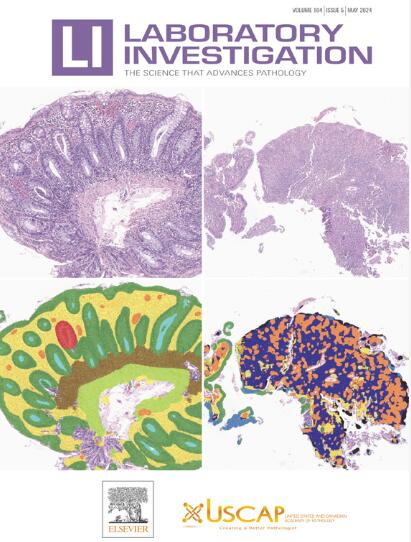Spatial Lipidomics Reveals Myelin Defects and Protumor Macrophage Infiltration in Malignant Peripheral Nerve Sheath Tumor Adjacent Nerves
IF 5.1
2区 医学
Q1 MEDICINE, RESEARCH & EXPERIMENTAL
引用次数: 0
Abstract
Malignant peripheral nerve sheath tumors (MPNSTs) are aggressive sarcomas arising from peripheral nerves, accounting for 3% to 5% of soft tissue sarcomas. MPNSTs often recur locally, leading to poor survival. Achieving tumor-free surgical margins is essential to prevent recurrence, but current methods for determining tumor margins are limited, highlighting the need for improved biomarkers. In this study we investigated the degree to which MPNST extends into nerves adjacent to tumors. Alterations to the lipidome of MPNST and adjacent peripheral nerves were assessed using spatial lipidomics. Tissue samples from 5 patients with MPNST were analyzed, revealing alterations of the lipid profile extending into the peripheral nerves beyond what was expected based on macroscopic and histologic observations. Integration of spatial lipidomics and high-resolution accurate-mass profiling identified distinct lipid profiles associated with healthy nerves, connective tissue, and tumors. Notably, histologically normal nerves exhibited myelin degradation and infiltration of protumoral M2 macrophages, particularly near the tumor. Furthermore, aberrant osmium staining patterns and loss of H3K27me3 staining in the absence of atypia were observed in a case with tumor recurrence. This exploratory study thereby highlights the changes occurring in the nerves affected by MPNST beyond what is visible on hematoxylin and eosin staining and provides leads for further biomarker studies, including aberrant osmium staining, to assess resection margins in MPNST.
空间脂质组学揭示了 MPNST 邻近神经的髓鞘缺陷和促肿瘤巨噬细胞浸润。
恶性周围神经鞘瘤(MPNST)是一种由周围神经引起的侵袭性肉瘤,占软组织肉瘤的 3-5%。恶性周围神经鞘瘤经常局部复发,导致生存率低下。实现无肿瘤手术切缘对防止复发至关重要,但目前确定肿瘤切缘的方法有限,这凸显了对改良生物标记物的需求。在这项研究中,我们调查了 MPNST 向肿瘤邻近神经延伸的程度。我们使用空间脂质组学评估了 MPNST 和邻近周围神经脂质体的变化。对 5 名 MPNST 患者的组织样本进行了分析,结果发现脂质谱的改变延伸到了外周神经,超出了宏观和组织学观察的预期。空间脂质组学与高分辨率精确质量分析相结合,确定了与健康神经、结缔组织和肿瘤相关的不同脂质特征。值得注意的是,组织学上正常的神经表现出髓鞘降解和亲肿瘤 M2 巨噬细胞的浸润,尤其是在肿瘤附近。此外,在一个肿瘤复发的病例中,还观察到异常的锇染色模式和 H3K27me3 染色缺失,但没有非典型性。因此,这项探索性研究强调了受 MPNST 影响的神经中发生的变化,这些变化超出了 H&E 所能看到的范围,并为进一步的生物标记物研究提供了线索,包括异常锇染色,以评估 MPNST 的切除边缘。
本文章由计算机程序翻译,如有差异,请以英文原文为准。
求助全文
约1分钟内获得全文
求助全文
来源期刊

Laboratory Investigation
医学-病理学
CiteScore
8.30
自引率
0.00%
发文量
125
审稿时长
2 months
期刊介绍:
Laboratory Investigation is an international journal owned by the United States and Canadian Academy of Pathology. Laboratory Investigation offers prompt publication of high-quality original research in all biomedical disciplines relating to the understanding of human disease and the application of new methods to the diagnosis of disease. Both human and experimental studies are welcome.
 求助内容:
求助内容: 应助结果提醒方式:
应助结果提醒方式:


